Pseuduvaria cerina is a species of tree in the Annonaceae family. It is endemic to Peninsular Malaysia. James Sinclair, the Scottish botanist who first formally described the species, named it after its waxy yellow inner petals.

Annona cascarilloides is a species of plant in the Annonaceae family. It is endemic to Cuba. According to William Edwin Safford, the species was named it after the pattern of its leaf veins which resemble species of a different genus, that at the time Safford was writing was called Cascarilla, but is now synonymous with the genera Croton and Ladenbergia. Despite this assertion by Safford, August Grisebach, the German botanist who first formally described the species, makes no mention of Cascarilla in his 1866 entry.

Annona crassivenia is a species of plant in the family Annonaceae. It is native to Cuba. William Edwin Safford, the American botanist who first formally described the species, named it after the thick tertiary veins that interconnect the secondary veins of its leaves.

Cremastosperma cauliflorum is a species of plant in the family Annonaceae. It is native to Brazil, Colombia, Ecuador and Peru. Robert Elias Fries, the Swedish botanist who first formally described the species, named it after its flowers which grow from its main trunk or stem.
Pseuduvaria aurantiaca is a species of plant in the family Annonaceae. It is endemic to New Guinea. Friedrich Anton Wilhelm Miquel, the Dutch botanist who first formally described the species using the basionym Orophea aurantiaca, named it after its orange colored fruit.
Duckeanthus is a genus of plant in the family Annonaceae. It is native to Brazil. It contains a single species, Duckeanthus grandiflorus. Robert Elias Fries, the Swedish botanist who first formally described it, named it in honor of Adolpho Ducke who collected the specimen he examined, and its large flowers.
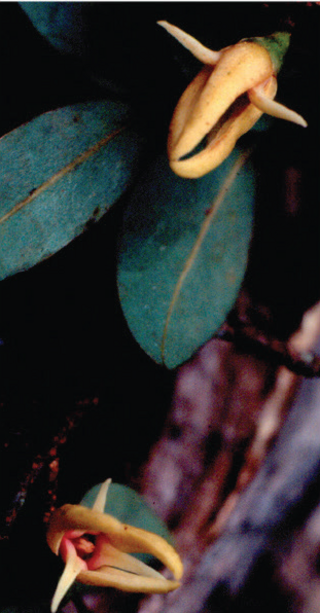
Xylopia arenaria is a species of plant in the Annonaceae family. It is native to Kenya, and Tanzania. Adolf Engler, the botanist who first formally described the species, named it after its growth in sandy places.
Xylopia macrantha is a species of plant in the Annonaceae family. It is native to Colombia, Costa Rica and Panama. José Jerónimo Triana and Jules Émile Planchon, the botanists who first formally described the species, named it after its large flowers.
Xylopia calophylla is a species of plant in the Annonaceae family. It is native to Bolivia, Brazil, Colombia, Ecuador, Peru and Venezuela. Robert Elias Fries, the botanist who first formally described the species, named it after its beautiful leaves.
Xylopia polyantha is a species of plant in the Annonaceae family. It is native to Bolivia, Brazil, Colombia, Ecuador, and Peru. Robert Elias Fries, the botanist who first formally described the species, named it after its many flowers.

Apocynum pictum is a species of plant in the Apocynaceae family. It is native to China, Kazakhstan, Kyrgyzstan, Mongolia, and Tajikistan. Alexander von Schrenk, the naturalist who first formally described the species, named it after colored flowers.
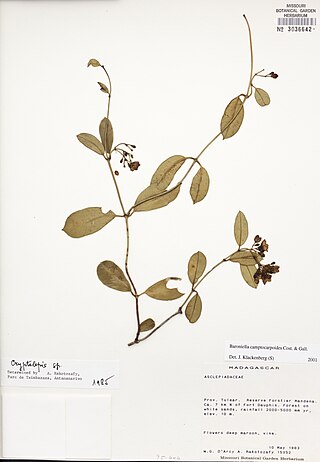
Baroniella camptocarpoides is a species of plant in the Apocynaceae family. It is endemic to Madagascar. Julien Noël Costantin and Ernest-Isidore Gallaud, the botanists who first formally described the species, named it after its resemblance to, but distinctiveness from, plants in the genus Camptocarpus.
Baroniella capillacea is a species of plant in the Apocynaceae family. It is endemic to Madagascar. Jens Klackenberg, the botanist who first formally described the species, named it after very narrow or thread-like leaves.
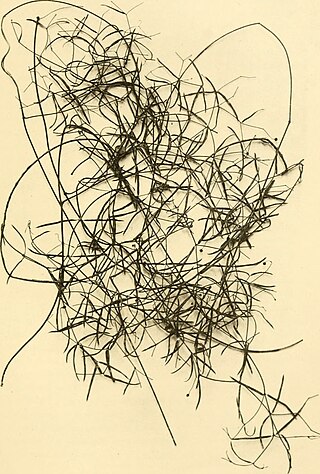
Baroniella linearis is a species of plant in the Apocynaceae family. It is endemic to Madagascar. Pierre Choux, the botanist who first formally described the species using the synonym Baseonema lineare, named it after its narrow leaves.

Batesanthus pseudopalpus is a species of plant in the Apocynaceae family. It is native to the Republic of the Congo and Gabon. Hendrik J. T. Venter and Rudolf L. Verhoeven, the botanists who first formally described the species, named it after the lobes of its corona which they said resemble the pedipalps of the rain spiders Palystes castaneus and Palystes superciliosus.

Batesanthus purpureus is a species of plant in the Apocynaceae family. It is native to the Cameroon, the Central African Republic, Democratic Republic of the Congo, Gabon, Guinea, Ivory Coast, Liberia, and Nigeria. Nicholas Edward Brown, the botanist who first formally described the species, named it after its purple flowers.
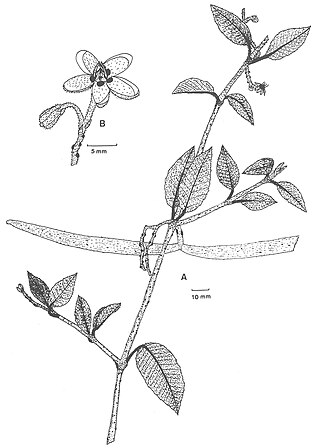
Buckollia tomentosa is a species of plant in the Apocynaceae family. It is native to the Ethiopia, Sudan, and Uganda. Eileen Adelaide Bruce, the botanist who first formally described the species, named it after the dense covering of wooly hairs on its flowers.

Buckollia volubilis is a species of plant in the Apocynaceae family. It is native to the Ethiopia, Kenya, Somalia, Tanzania and Uganda. Rudolf Schlechter, the botanist who first formally described the species, named it after its twining growth habit, using the synonymous name Raphionacme volubilis.
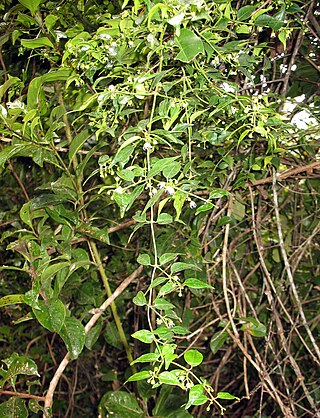
Camptocarpus acuminatus is a species of plant in the Apocynaceae family. It is endemic to the Madagascar. Pierre Choux,, the botanist who first formally described the species, named it after the tapering tips of its leaves, using the synonymous name Tanulepis acuminata.
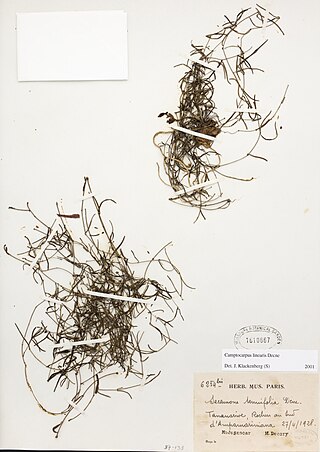
Camptocarpus linearis is a species of plant in the Apocynaceae family. It is endemic to Madagascar. Joseph Decaisne, the botanist who first formally described the species, named it after its narrow leaves.













